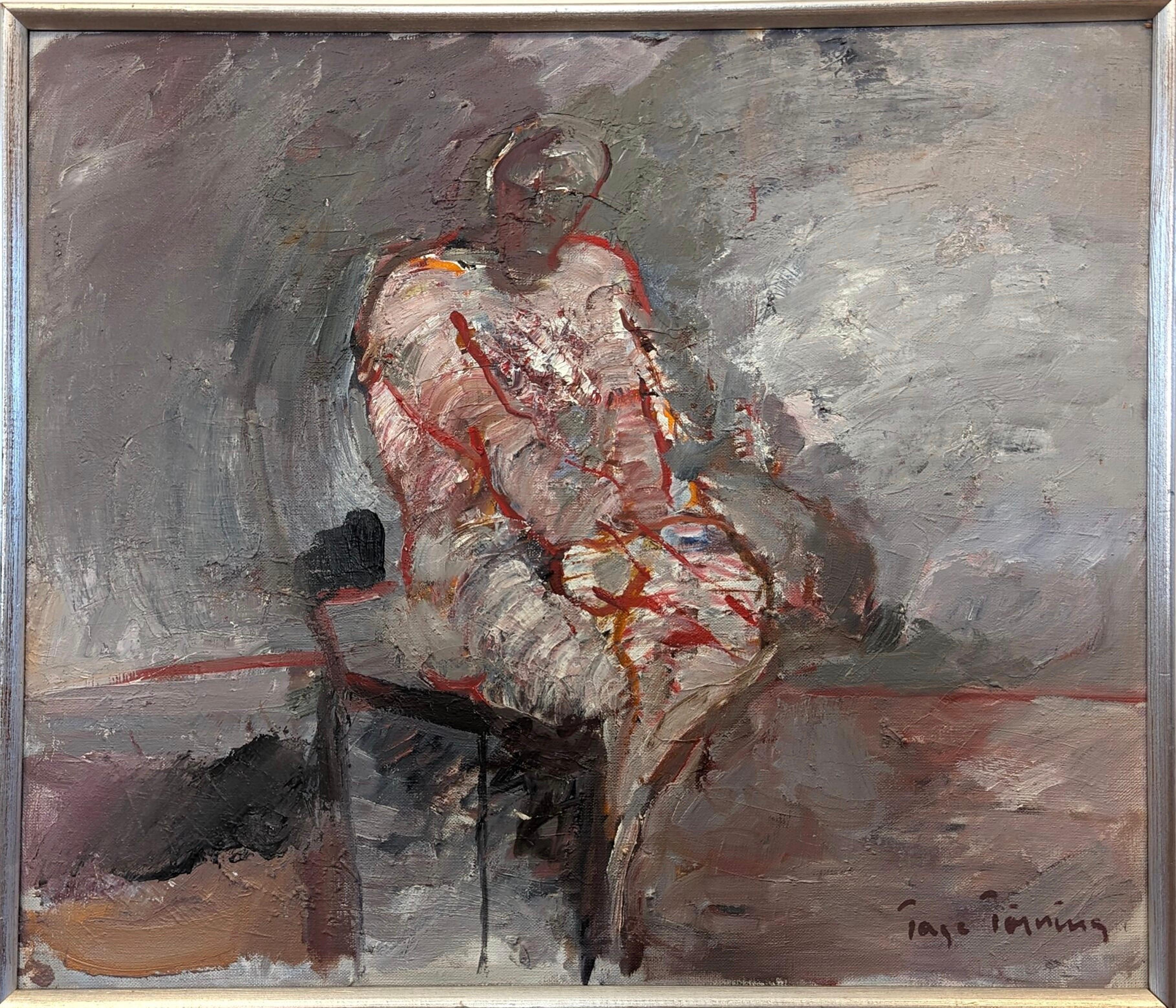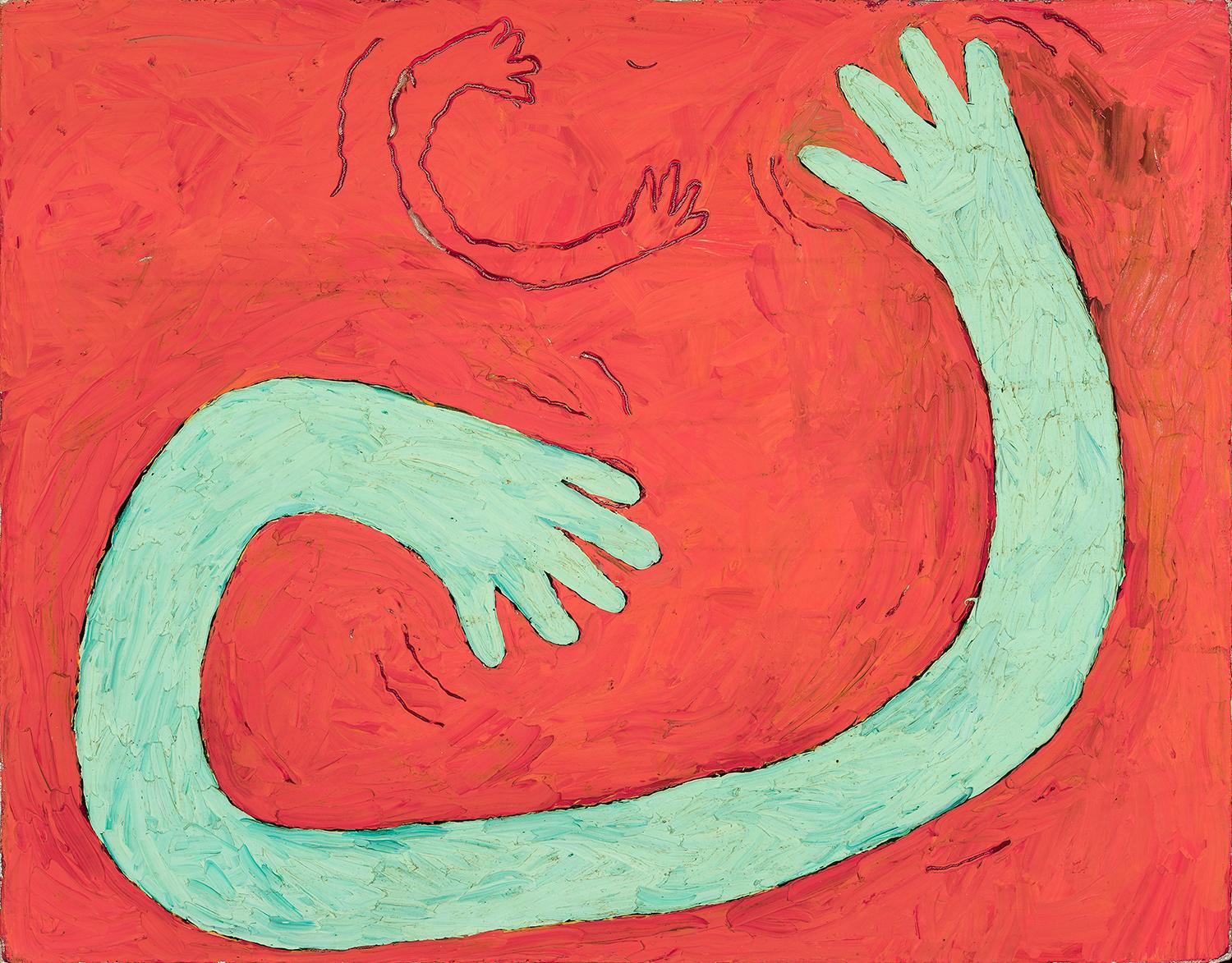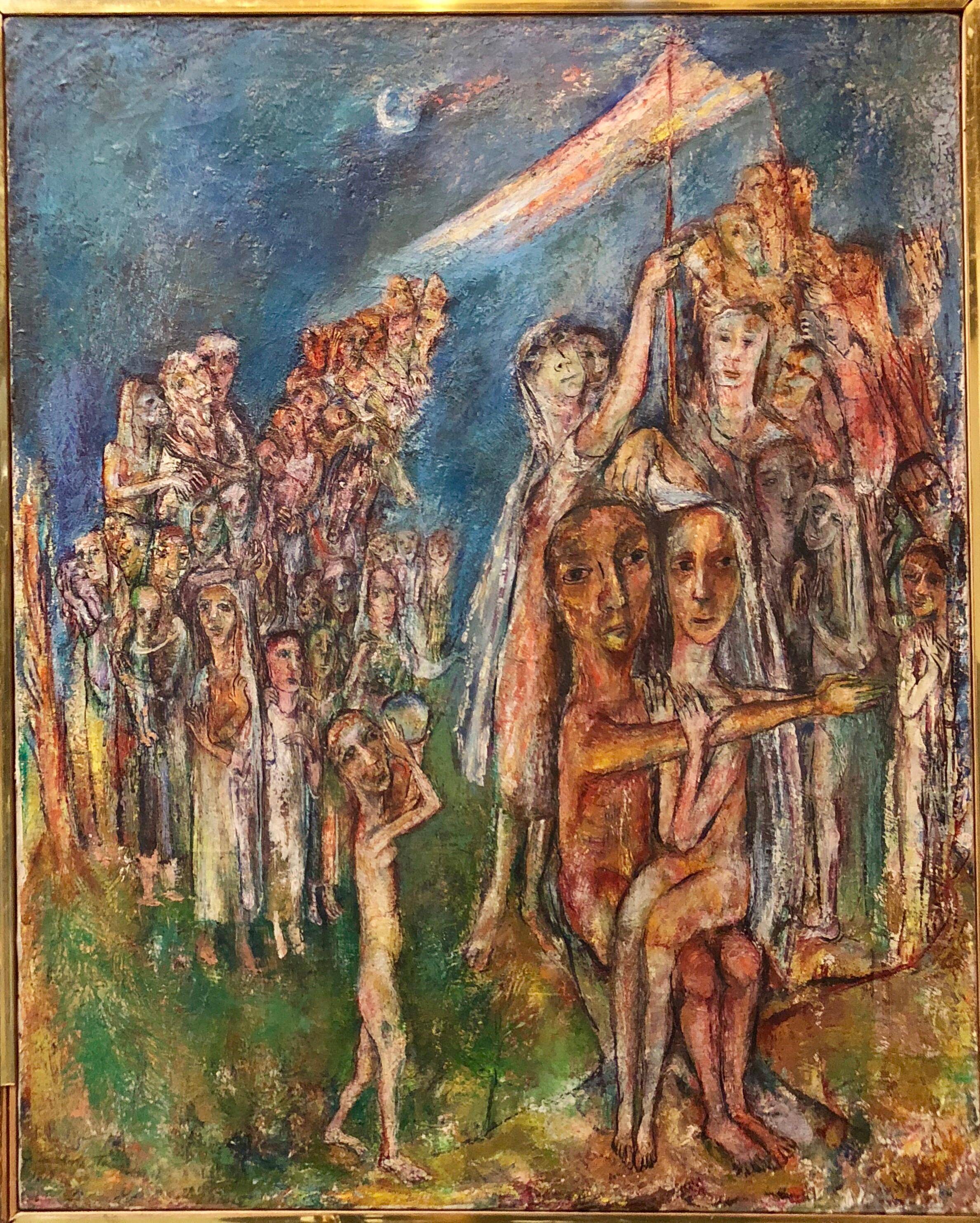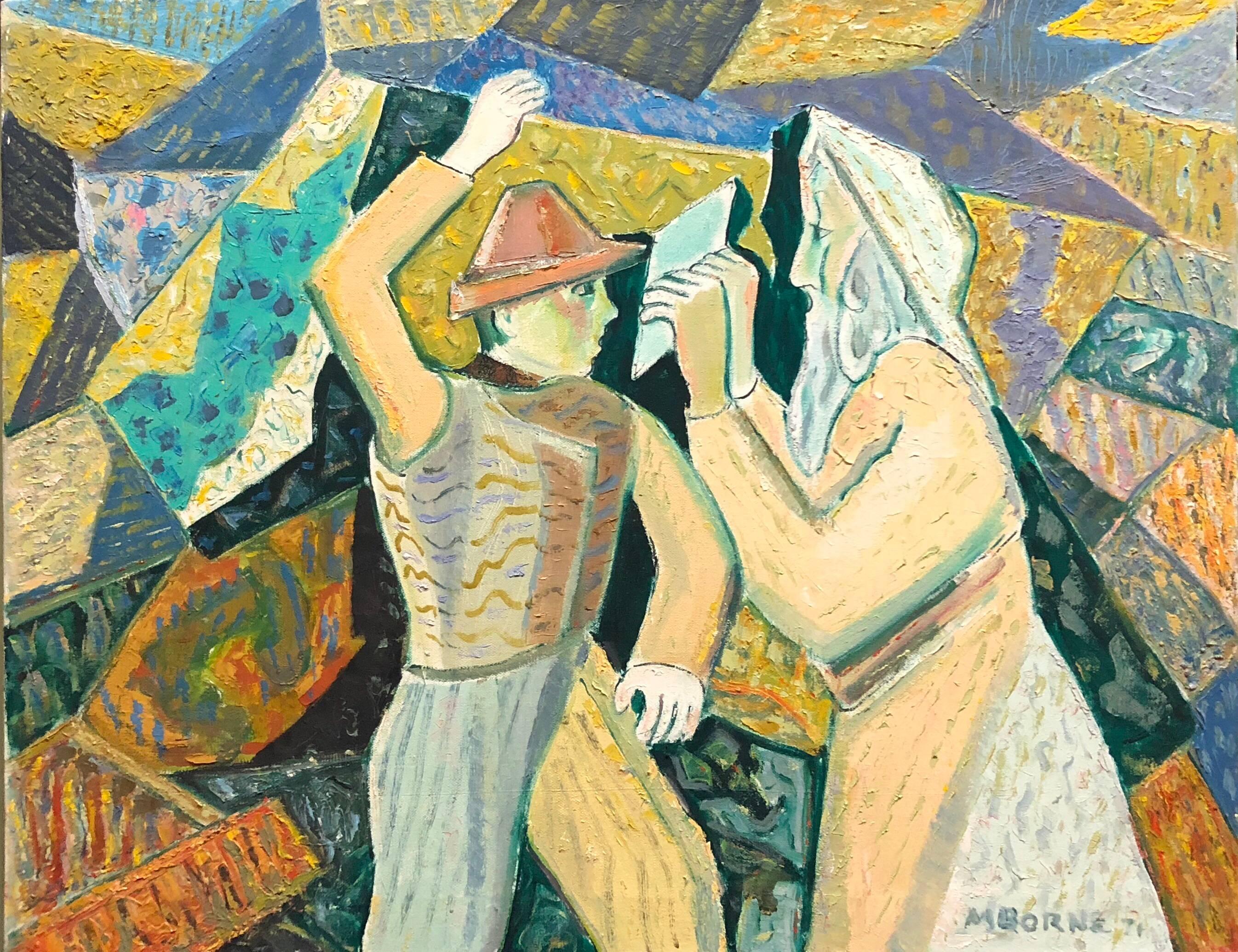Items Similar to "Gathering by the Trees, " Charles Marcon, figurative, abstract, 1959, modern
Want more images or videos?
Request additional images or videos from the seller
1 of 7
Charles Marcon"Gathering by the Trees, " Charles Marcon, figurative, abstract, 1959, modern1959
1959
About the Item
Born in Terrenoire in the Loire, France, self-taught painter Charles Marcon was encouraged by Madeleine Castaing and Paulette Jourdain. Marcon exhibited throughout Paris and in Arles, Switzerland, London, Montreal, New York, San Francisco, Brussels and Caracas, Venezuela. He was represented by gallerist Jean-Claude Bellier from the mid-1950's through the 80's.
- Creator:Charles Marcon (1920, French)
- Creation Year:1959
- Dimensions:Height: 25.63 in (65.11 cm)Width: 39.38 in (100.03 cm)
- Medium:
- Movement & Style:
- Period:
- Condition:
- Gallery Location:Wiscasset, ME
- Reference Number:1stDibs: LU7522754643

About the Seller
5.0
Gold Seller
These expertly vetted sellers are highly rated and consistently exceed customer expectations.
Established in 1985
1stDibs seller since 2014
159 sales on 1stDibs
Typical response time: 1 hour
- ShippingRetrieving quote...Ships From: Wiscasset, ME
- Return PolicyA return for this item may be initiated within 14 days of delivery.
More From This SellerView All
- "Seated Nude, " Norman Rubington, oil on paper, Mid-Century, Hirschhorn MuseumBy Norman RubingtonLocated in Wiscasset, MEBorn in New Haven, Connecticut in 1921, artist Norman Rubington studied at the Yale School of Fine Arts and Ecole des Beaux Arts in Paris where he participated in a number of group exhibitions and his first solo show at the Salon d'Automne in 1948, which received high acclaim. Following his studies, he returned to the States and exhibited in a series of shows in Boston, New York and San Francisco. Rubington was awarded a grant from the Tiffany Foundation, a Guggenheim Fellowship, the Prix de Rome prize and was a fellow of the McDowell Art Colony in New Hampshire. Rubington exhibited at the Salon d'Automne, Paris, City Center, New York, Carl Siembab Gallery, Boston, Berman Museum of Art, Pennsylvania, American Academy, Rome, Museum of Fine Arts, San Francisco, Corcoran Gallery, Washington D.C., Art Institute of Chicago, American Art Gallery, Copenhagen, Rome Art Club, and Museo Berera, Milan. Rubington's work is held in numerous private and public collections including permanent collections of the J.H. Hirschhorn Museum, Washington, D.C., San Francisco Museum of Art, San Francisco, CA, Obelisk Gallery, London, Court Gallery, Copenhagen, Grace Cathedral...Category
Mid-20th Century Modern Figurative Paintings
MaterialsOil, Paper
- Yellow Nude, oil on paper, figural, modernBy Norman RubingtonLocated in Wiscasset, MEBorn in New Haven, Connecticut in 1921, artist Norman Rubington studied at the Yale School of Fine Arts and Ecole des Beaux Arts in Paris where he participated in a number of group exhibitions and his first solo show at the Salon d'Automne in 1948, which received high acclaim. Following his studies, he returned to the States and exhibited in a series of shows in Boston, New York and San Francisco. Rubington was awarded a grant from the Tiffany Foundation, a Guggenheim Fellowship, the Prix de Rome prize and was a fellow of the McDowell Art Colony in New Hampshire. Rubington exhibited at the Salon d'Automne, Paris, City Center, New York, Carl Siembab Gallery, Boston, Berman Museum of Art, Pennsylvania, American Academy, Rome, Museum of Fine Arts, San Francisco, Corcoran Gallery, Washington D.C., Art Institute of Chicago, American Art Gallery, Copenhagen, Rome Art Club, and Museo Berera, Milan. Rubington's work is held in numerous private and public collections including permanent collections of the J.H. Hirschorn Museum, Washington, D.C., San Francisco Museum of Art, San Francisco, CA, Obelisk Gallery, London, Court Gallery, Copenhagen, Grace Cathedral...Category
Mid-20th Century Modern Interior Paintings
MaterialsOil, Paper
- "By the Window, " Leon Kroll, oil, figurative art, nude, modernismBy Leon KrollLocated in Wiscasset, MELeon Kroll was a painter, lithographer, art critic and teacher who was born in 1884 in New York City. Living his professional life in New York City and Chicago, he summered in Rockpo...Category
20th Century Modern Figurative Paintings
MaterialsOil, Canvas
- "Woman with Bird, " Nahum Tschacbasov, figurative, modern, 1956By Nahum TschacbasovLocated in Wiscasset, MEBorn in Baku, Russia in 1899, prolific avant-garde artist and painter Nahum Tschacbasov studied in Paris with Leopold Gottlieb, Marcel Gromaire and Fe...Category
1950s Modern Figurative Paintings
MaterialsOil, Board
- "Objects on Table" by Henry Kallem, Mid-Century, American Abstract Still LifeBy Henry KallemLocated in Wiscasset, MEHenry Kallem was born in Philadelphia, Pennsylvania in 1912. His first exposure to art was through his father, artist Morris Kallem. Later Kallem studied art at the National Academy ...Category
Mid-20th Century Modern Abstract Paintings
MaterialsOil, Board
- Blue Still LifeLocated in Wiscasset, METhis vibrant work by noted 20th century American artist, Joel Durand, employs a bold palette and sophisticated approach in this dramatic and abstracted sti...Category
1950s Modern Abstract Paintings
MaterialsBoard, Oil
You May Also Like
- Ceremonial Dancers oil and tempera painting by Julio De DiegoBy Julio de DiegoLocated in Hudson, NYArtwork measures 48" x 30" and framed 56 ¼" x 38 ¼" x 3" Provenance: John Heller Gallery, NYC, circa 1975 (label verso) The artist's daughter Corbino Galleries, Sarasota, FL (1990)...Category
1940s Modern Abstract Paintings
MaterialsMasonite, Oil, Tempera
- The Magician oil and tempera painting by Julio de DiegoBy Julio de DiegoLocated in Hudson, NYJulio De Diego’s Atomic Series paintings made an extraordinary statement regarding the shock and fear that accompanied the dawn of the nuclear age. In the artist’s own words, “Scientists were working secretly to develop formidable powers taken from the mysterious depths of the earth - with the power to make the earth useless! Then, the EXPLOSION! . . . we entered the Atomic Age, and from there the neo-Atomic war begins. Explosions fell everywhere and man kept on fighting, discovering he could fight without flesh.” To execute these works, De Diego developed a technique of using tempera underpainting before applying layer upon layer of pigmented oil glazes. The result is paintings with surfaces which were described as “bonelike” in quality. The forms seem to float freely, creating a three-dimensional visual effect. In the 1954 book The Modern Renaissance in American Art, author Ralph Pearson summarizes the series as “a fantastic interpretation of a weighty theme. Perhaps it is well to let fantasy and irony appear to lighten the devastating impact. By inverse action, they may in fact increase its weight.” Exhibited 1964 Marion Koogler McNay Art Institute, San Antonio, Texas This work retains its original frame which measures 54" x 42" x 2" About this artist: Julio De Diego crafted a formidable persona within the artistic developments and political struggles of his time. The artist characterized his own work as “lyrical,” explaining, “through the years, the surrealists, the social-conscious painters and the others tried to adopt me, but I went my own way, good, bad or indifferent.” [1] His independence manifested early in life when de Diego left his parent’s home in Madrid, Spain, in adolescence following his father’s attempts to curtail his artistic aspirations. At the age of fifteen he held his first exhibition, set up within a gambling casino. He managed to acquire an apprenticeship in a studio producing scenery for Madrid’s operas, but moved from behind the curtains to the stage, trying his hand at acting and performing as an extra in the Ballet Russes’ Petrouchka with Nijinsky. He spent several years in the Spanish army, including a six-month stretch in the Rif War of 1920 in Northern Africa. His artistic career pushed ahead as he set off for Paris and became familiar with modernism’s forays into abstraction, surrealism, and cubism. The artist arrived in the U.S. in 1924 and settled in Chicago two years later. He established himself with a commission for the decoration of two chapels in St. Gregory’s Church. He also worked in fashion illustration, designed magazine covers and developed a popular laundry bag for the Hotel Sherman. De Diego began exhibiting through the Art Institute of Chicago in 1929, and participated in the annual Chicago Artists Exhibitions, Annual American Exhibitions, and International Water Color Exhibitions. He held a solo exhibition at the Art Institute of Chicago in the summer of 1935. Though the artist’s career was advancing, his family life had deteriorated. In 1932 his first marriage dissolved, and the couple’s young daughter Kiriki was sent to live with friend Paul Hoffman. De Diego continued to develop his artistic vocabulary with a growing interest in Mexican art. He traveled throughout the country acquainting himself with the works of muralists such as Carlos Merida, and also began a collection of small native artifacts...Category
1940s American Modern Abstract Paintings
MaterialsMasonite, Oil, Tempera
- St. Atomic oil and tempera painting by Julio de DiegoBy Julio de DiegoLocated in Hudson, NYJulio De Diego’s Atomic Series paintings made an extraordinary statement regarding the shock and fear that accompanied the dawn of the nuclear age. In the artist’s own words, “Scientists were working secretly to develop formidable powers taken from the mysterious depths of the earth - with the power to make the earth useless! Then, the EXPLOSION! . . . we entered the Atomic Age, and from there the neo-Atomic war begins. Explosions fell everywhere and man kept on fighting, discovering he could fight without flesh.” To execute these works, De Diego developed a technique of using tempera underpainting before applying layer upon layer of pigmented oil glazes. The result is paintings with surfaces which were described as “bonelike” in quality. The forms seem to float freely, creating a three-dimensional visual effect. In the 1954 book The Modern Renaissance in American Art, author Ralph Pearson summarizes the series as “a fantastic interpretation of a weighty theme. Perhaps it is well to let fantasy and irony appear to lighten the devastating impact. By inverse action, they may in fact increase its weight.” Exhibited 1950 University of Illinois at Urbana "Contemporary American Painting" 1964 Marion Koogler McNay Art Institute, San Antonio, Texas This work retains its original frame which measures 54" x 36" x 2". About this artist: Julio De Diego crafted a formidable persona within the artistic developments and political struggles of his time. The artist characterized his own work as “lyrical,” explaining, “through the years, the surrealists, the social-conscious painters and the others tried to adopt me, but I went my own way, good, bad or indifferent.” [1] His independence manifested early in life when de Diego left his parent’s home in Madrid, Spain, in adolescence following his father’s attempts to curtail his artistic aspirations. At the age of fifteen he held his first exhibition, set up within a gambling casino. He managed to acquire an apprenticeship in a studio producing scenery for Madrid’s operas, but moved from behind the curtains to the stage, trying his hand at acting and performing as an extra in the Ballet Russes’ Petrouchka with Nijinsky. He spent several years in the Spanish army, including a six-month stretch in the Rif War of 1920 in Northern Africa. His artistic career pushed ahead as he set off for Paris and became familiar with modernism’s forays into abstraction, surrealism, and cubism. The artist arrived in the U.S. in 1924 and settled in Chicago two years later. He established himself with a commission for the decoration of two chapels in St. Gregory’s Church. He also worked in fashion illustration, designed magazine covers and developed a popular laundry bag for the Hotel Sherman. De Diego began exhibiting through the Art Institute of Chicago in 1929, and participated in the annual Chicago Artists Exhibitions, Annual American Exhibitions, and International Water Color Exhibitions. He held a solo exhibition at the Art Institute of Chicago in the summer of 1935. Though the artist’s career was advancing, his family life had deteriorated. In 1932 his first marriage dissolved, and the couple’s young daughter Kiriki was sent to live with friend Paul Hoffman. De Diego continued to develop his artistic vocabulary with a growing interest in Mexican art. He traveled throughout the country acquainting himself with the works of muralists such as Carlos Merida, and also began a collection of small native artifacts...Category
1940s American Modern Abstract Paintings
MaterialsMasonite, Oil, Tempera
- Inevitable Day – Birth of the Atom oil and tempera painting by Julio De DiegoBy Julio de DiegoLocated in Hudson, NYJulio De Diego’s Atomic Series paintings made an extraordinary statement regarding the shock and fear that accompanied the dawn of the nuclear age. In the artist’s own words, “Scientists were working secretly to develop formidable powers taken from the mysterious depths of the earth - with the power to make the earth useless! Then, the EXPLOSION! . . . we entered the Atomic Age, and from there the neo-Atomic war begins. Explosions fell everywhere and man kept on fighting, discovering he could fight without flesh.” To execute these works, De Diego developed a technique of using tempera underpainting before applying layer upon layer of pigmented oil glazes. The result is paintings with surfaces which were described as “bonelike” in quality. The forms seem to float freely, creating a three-dimensional visual effect. In the 1954 book The Modern Renaissance in American Art, author Ralph Pearson summarizes the series as “a fantastic interpretation of a weighty theme. Perhaps it is well to let fantasy and irony appear to lighten the devastating impact. By inverse action, they may in fact increase its weight.” Bibliography Art in America, April 1951, p.78 About this artists: Julio De Diego crafted a formidable persona within the artistic developments and political struggles of his time. The artist characterized his own work as “lyrical,” explaining, “through the years, the surrealists, the social-conscious painters and the others tried to adopt me, but I went my own way, good, bad or indifferent.” [1] His independence manifested early in life when de Diego left his parent’s home in Madrid, Spain, in adolescence following his father’s attempts to curtail his artistic aspirations. At the age of fifteen he held his first exhibition, set up within a gambling casino. He managed to acquire an apprenticeship in a studio producing scenery for Madrid’s operas, but moved from behind the curtains to the stage, trying his hand at acting and performing as an extra in the Ballet Russes’ Petrouchka with Nijinsky. He spent several years in the Spanish army, including a six-month stretch in the Rif War of 1920 in Northern Africa. His artistic career pushed ahead as he set off for Paris and became familiar with modernism’s forays into abstraction, surrealism, and cubism. The artist arrived in the U.S. in 1924 and settled in Chicago two years later. He established himself with a commission for the decoration of two chapels in St. Gregory’s Church. He also worked in fashion illustration, designed magazine covers and developed a popular laundry bag for the Hotel Sherman. De Diego began exhibiting through the Art Institute of Chicago in 1929, and participated in the annual Chicago Artists Exhibitions, Annual American Exhibitions, and International Water Color Exhibitions. He held a solo exhibition at the Art Institute of Chicago in the summer of 1935. Though the artist’s career was advancing, his family life had deteriorated. In 1932 his first marriage dissolved, and the couple’s young daughter Kiriki was sent to live with friend Paul Hoffman. De Diego continued to develop his artistic vocabulary with a growing interest in Mexican art. He traveled throughout the country acquainting himself with the works of muralists such as Carlos Merida, and also began a collection of small native artifacts...Category
1940s American Modern Abstract Paintings
MaterialsMasonite, Oil, Tempera
- 1988 "Utopia" Abstract Oil Painting on Canvas Illustrator Bill ShieldsLocated in Arp, TXWilliam Stephens Shields, Jr., 1925 - 2010 "Utopia" 1988 Oil on canvas 60"x48" artist framed Signed lower right William Stephens Shields, Jr., 1925 - 2010 He was born in san Francisco, in 1931, Bill moved to Texas, where he grew up. Moved to New York in 1940 and later joined the Naval Air Corps at the age of 18. He served as an Aviation Cadet in the U.S. Navy from 1943 to 1945. At the end of WWII, Bill returned to Texas. At 21, Bill re-focused his energy and enrolled in the Chicago Academy of Fine Art as an Illustration major. What followed was a whirlwind of success, great friendships and a sense of belonging he had never before experienced. Art was his calling and the art-world could not have been less prepared for the likes of Bill Shields...Category
Late 20th Century American Modern Abstract Paintings
MaterialsCanvas, Oil
- 20th C. Figurative Abstract Painting Cleveland School African American ArtistBy Beni E. KoshLocated in Beachwood, OHBeni E. Kosh/Charles Elmer Harris (American, 1917-1993) Untitled Oil on canvas board Estate stamped #611 verso 24 x 18 inches Charles Elmer Harris was born in 1917 in Cleveland, Oh...Category
20th Century American Modern Figurative Paintings
MaterialsOil





